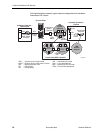
1. About FrameSaver DSL Devices
1-6 December 2002 9700-A2-GB20-20
Trap Event Log. Shows the SNMP (Simple Network Management Protocol)
trap event log for the FrameSaver unit, with the most recent events first,
keeping a running total for all trap events stored, the amount of time since the
event was logged, plus a description of the trap.
LMI Packet Capture. Provides a way of uploading LMI data that has been
captured on the user data port in a trace file so the data can be uploaded and
transferred to a Network Associates Sniffer for analysis, or viewed via the
menu-driven user interface. When viewed from the menu-driven user
interface, the 12 most recent LMI messages are displayed.
Enhanced Ping Operation. FrameSaver devices can check connectivity and
roundtrip response time to any remote device in either direction, via the
FrameSaver internal management network or the data path.
Payload Management. Any standard, non-management DLCI can be
designated as payload managed, providing management directly from a user
data PVC, and support for Telnet, ping, SNMP, and FTP.
Endpoint identification. FrameSaver units can identify all destination units
via a specified Circuit (DLCI or VPI/ VCI). Third party destinations
(non-FrameSaver units) may be manually configured as endpoints.
Class of Service. Up to 7 Class of Service (COS) types are supported.
Advanced SLM Feature Set
The following additional features are provided with the Advanced SLM Feature set:
TruePut
™
Technology. Using FDR/DDR (Frame Delivery Ratio/Data Delivery
Ratio), throughput (within and above CIR, between CIR and EIR, and above
EIR) can be precisely measured, eliminating averaging inaccuracies.
Intelligent Service Level Verification (SLV). Provides accurate throughput,
latency, and availability measurements to determine network performance and
whether SLAs (Service Level Agreements) are being met, along with SLA
reporting.
RMON Alarms and Configurable Alarm Thresholds. Using the OpenLane
system, provides the ability to change the SLA parameters and the RMON
alarm thresholds to correct problems in real-time before the SLA is violated.
RMON-Based User History Statistics Gathering. Provides everything
needed to monitor network service levels, plus throughput with accurate data
delivery, network latency, and LMI and PVC availability. Continuous roundtrip
latency testing and reporting, as well as CIR relationship to transmitted and
received data performance statistics, are included. In addition, port bursting
statistics are kept for all frame relay links for accurate calculation of utilization.
FTP User History Poller. The OpenLane system provides a user history bulk
collector that generates a database for graphical and historical reporting.


















